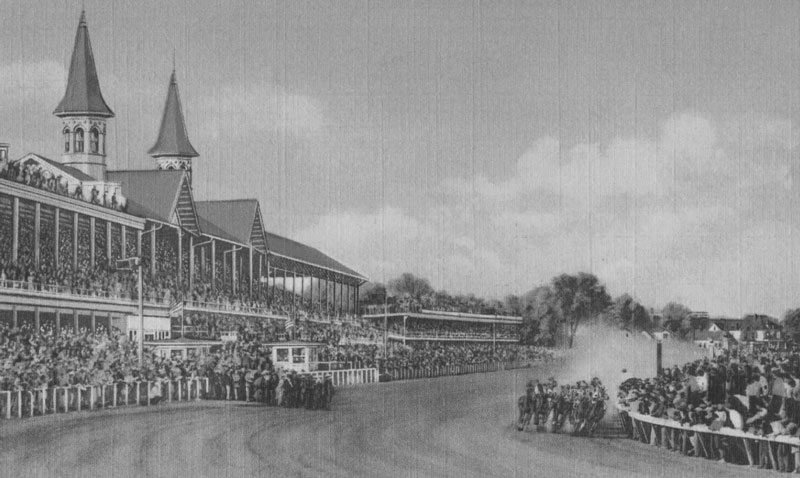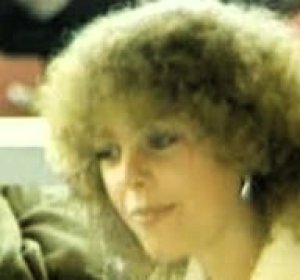Cover photo: Jockey Don Meade on the inside spars with Herb Fisher. Meade gets the call with longshot Broker’s Tip. Photo provided.
THE BEGINNINGS
It is called “The Run for the Roses” and “The Greatest Two Minutes in Sports.”
Call it what you may, there is no doubt that The Kentucky Derby is America’s greatest horserace. Let’s go back and take a look at some of its glorious history. So many great, near great, and not so great renditions of the race have been witnessed. We can only cover so much here. So let’s get started.
It all started one hundred and forty five years ago. It was 1875. A racing meet began in Louisville, Kentucky. The course was named Churchill Downs. In that first year of the track’s existence, the initial Kentucky Derby was contested. The date of the race was May 17. A three-year-old colt, Aristides, took the event. That fact alone lends his name to the lore of the sport. Also worth noting, the first Derby was run at the distance of a mile and a half. It wasn’t until 1896 that the race was shortened to the classic distance of a mile and a quarter. Many of the three-year-old colts that won the nineteenth century runnings of the race are now just footnotes in hisory.
What is of more interest to that era is the dominance of African American jockeys in “The Sport of Kings.” They were led by Isaac Murphy who took home three Derbys. He is considered one of the greatest race riders of all time and a charter member of horseracing’s Hall of Fame. Right behind Murphy were Willie Simms and Jimmy Winkfield. They took a pair of Derbys each at the turn of the century. Let’s not forget Oliver Lewis who guided Aristades to the winner’s circle in the inaugural race. As a group they had collectively won fifteen of the first twenty eight renditons of The Kentucky Derby.
THE TWENTIETH CENTURY
Let’s move ahead to 1915. Harry Payne Whitney’s filly Regret took center stage in this Derby. She became the first female winner of the race. It would take sixty one years to duplicate this feat. Genuine Risk got hers in 1976. Winning Colors made it a hat trick when she held on to win the 1988 version. No filly has prevailed since.
1918 brought an end to the great World War 1. At Churchill Downs a colt with the apropos name Exterminator took the Derby. He would go on to become one of the great handicap stars of the American Turf.
Sir Barton came along a year later. He got his Derby. He added the Preakness and Belmont Stakes to his resume to become the first of thirteen Triple Crown Champions. Of note, the term Triple Crown wasn’t used as a title for the series until 1930. America’s foremost Turf Writer Charles Hatton coined the phrase in the year of Gallant Fox, the second of the TC Champions.
The Roaring Twenties brought the immortal Man O’ War to the forefront of sports pages across the country. His owner Samuel Riddle did not believe a colt should be asked to go ten furlongs so early in his three-year-old campaign.
Man O’ War skipped the 1920 Derby in what surely would have been a cakewalk.
1923 came along. Harry Sinclair’s famed Rancocas Farm sent out the future Hall of Famer Zev. He easily took the race. Warren Harding, America’s twenty-ninth President, died unexpectedly that August. Soon after news of a major scandal in his administration hit home. Sinclair was heavily implicated in what became known as “Teapot Dome.” He ended up in Federal prison. With that came the end of Rancocas Farm, one of racing’s premier racing venues in the Golden Age of the sport.
The 1925 Derby was won by Flying Ebony. Of note here, it was the first Derby that was broadcast on radio. Also it marked the great Earl Sande’s second Derby win. He had previously won it with Zev. He would win it one more time, five years later.
The clock moves forward to 1930. This was the Year of Gallant Fox. William Woodward and his beloved Belair Stud notched their first Derby. Sande got his third. Belair would do it again in 1935 with Galland Fox’s progeny Omaha. Both these Derby winners went on to take the Triple Crown, the only father and son tandem to accomplish the feat.
A year later, the 1931 event was moved to the first Saturday in May. Not realized at the time, this would become a Kentucky Derby tradition now in its eighty-ninth year.
The 1933 race deserves a look. The winner Broker’s Tip only had one win in his entire career. You guessed it, The Kentucky Derby. The story doesn’t end there. Don Mead, Broker’s Tip jockey and his counterpart Herb Fisher aboard Head Play beat on and whipped each other in a ferocious nose-to-nose stretch drive. Inexplicably, neither rider was suspended for the rough riding. The finish of the race was called official with Broker’s Tip the winner by a nose. Ah... The Good Old Days!
The year 1937 brought a change in thinking from Sam Riddle. Riddle faced the same dilemma that he was in seventeen years earlier. This time he had War Admiral, a son of Man O’ War as a Derby contender. He decided to enter him. The decision was a wise one. The Admiral not only took the Derby, he went on to sweep the Preakness and Belmont Stakes to become the third Triple Crown winner of the decade.
The Forties, brought one champion after another to Churchill Downs on Derby Day. Whirlaway was the first of a record eight winners produced by Warren Wright’s Calumet Farms. The Dean of America’s race riders Eddie Arcaro took him home for his second Derby score. When it was all said and done Arcaro would end up with five Kentucky Derby Trophies. Whirlaway went on to a Triple Crown season and became the only winner of that series to also win the Traver’s Stakes here at the Spa.
Move ahead to 1943. It was all Count Fleet. The great Johnny Longden took him on a joyride as he took the Derby with the utmost ease. He then buried his competition in the final two jewels of the crown. HIs dominance of that series wasn’t duplicated until Secretariat came along in 1973. Count Fleet...An all time great!
The war ended in 1945. A year later King Ranch and trainer Max Hirsch sent out Assault to contest the Derby... and assault he did. He breezed to an eight length victory on his way to The Triple Crown Trophy. He became the third colt in six years to sweep the crown.
Two years later storied Calumet iced the Derby with the immortal Citation. He went on to obliterate all competition to seize the fourth Triple Crown of the decade.
1949 brought another Derby Trophy to Calumet. The immensely talented Steve Brooks guided Ponder to the winner circle. This one was special. The race was locally televised for the first time. Three years later it was presented nationwide.
The 1950’s opened with a bang. A sixteen-year-old apprentice jockey named Bill Boland guided Middleground to victory in the first Derby of that decade. Boland would go on to a Hall of Fame career that spanned twenty years.
Three years later the Racing Gods were not in a kindly mood. Alfred Gwynn Vanderbilt brought his super horse Native Dancer to the Bluegrass State looking to conquer the Derby. In one of the worst rides in Kentucky Derby history, jockey Eric Guerin piloted the Great Dancer on a scenic tour of the course. As entrepreneur and racetrack legend Tommy Roberts relayed a quotable quip to this writer...”Guerin put him everywhere except the ladies room.” It was the only time the Big Gray lost a race. Despite his Derby loss, he is considered one of the greatest racehorses of all time...One of the immortals.
1955 brought a Derby that pitted East verses West. Belair Stud sent out the great star Nashua to compete against Rex Ellsworth’s West coast invader Swaps. The cowboys from California got the best of the East coast bluebloods in this one. Swaps prevailed, setting up a Match Race later that summer. Nashua got even this time besting Swaps by six lengths. They both rank among America’s Greatest Champions and hold highly respected positions in the Hall of Fame here on Union Avenue.
Two years later it was a Derby to remember. Three of the toughest gladiators in the history of the sport knocked heads to get the prize. They were Bold Ruler, Round Table, and Gallant Man. It was not to be their day. In a nightmare ending Bill Shoemaker aboard Gallant Man misjudged the finish line. This gave Bill Hartack the greatest gift of his fabulous career. He got the nod over Gallant Man by a nose with lightly regarded Iron Liege. In so doing Hartack seized his second of a co-record five Kentucky Derby scores.
1958 saw another Calumet star Tim Tam take the Derby. Five weeks later he went to the Belmont Stakes as a prohibitive favorite to take the Triple Crown. At the top of the stretch he took the lead. In a split second Lady Luck took a devastating turn. Tim Tam suffered a career ending leg injury. Yet with the grit and courage of a champion he was able to finish the race a game second to the winner Cavan.
The 1961 version of the Derby was all Carry Back. Without question he was a fan favorite. He was owned by Jack Price, a self-made millionaire who loved the spotlight. He acquired the services of Johnny Sellers to ride his stead. Carry Back with his patented come from behind move gave his fans everything they could ask for as he swept past the field and nailed down his Derby. Johhny Sellers would wow fans here at the Spa a year later when he finished the then four week meeting with thirty-five wins and a highly deserved riding title.
Three years later Canada came to the Derby. That country’s leading horseracing figure E. P. Taylor brought the great Northern Dancer to Louisville. This guy was about to make racing fans North of the Border proud. This Dancer was trained by the stylish Argentinean, Horatio Luro internationally known as “El Grand Senor” a title of the greatest respect in his native Spanish language. Bill Hartack, The Dean of Kentucky Derby race riding had the mount. He held off a late challenge by the formidable Hill Rise and got his Derby setting a new track record for the ten furlongs. On his retirement from racing Northern Dancer became one of the most important sires to ever enter a breeding shed. His DNA stretches universally in the bloodlines of thoroughbred champions.
The great Damascus came to Louisville in 1967 looking to take the roses for the asking. Unfortunately he was spooked by the large crowd. Plainly speaking it was not his day. He finished a lackluster third. Damascus went on to become one of the premier stars of the turf. His head-to-head battles with Dr Fager are the stuff of legends.
The following year disaster struck the famed race. Peter Fuller won the 1968 version of the Derby with Dancer’s Image. The scene at the winners circle was one that you would expect from a racing stable that had just captured America’s greatest race. The exhilaration was short lived. A post race urinalysis found traces of Phenylbutazone, a painkiller that was illegal and could not be administered to horses racing in Kentucky. The State Racing Commission came down with this harsh verdict. Dancer’s Image was disqualified and placed last. The Derby, it’s trophy, and purse money were awarded to Calumet Farms and Forward Pass who finished second in the race. Courtroom battles lingered for years over the decision. The original ruling after all was litigated prevailed. With it, a sorry chapter in the annals of the Kentucky Derby was finally put to rest.
The sixties ended on a high note. Majestic Prince became the first unbeaten colt to take the Derby since Morvich pulled it off in 1922. Of note here, Johnny Longden became the first and only horseman to win the race as both a jockey and trainer. Also, it was Bill Hartack’s Swan Song as he rode his fifth and final Kentucky Derby winner.
Next week we will take a look at the Derby from Secretariat and the 1970’s through the first two decades of this Century.






































